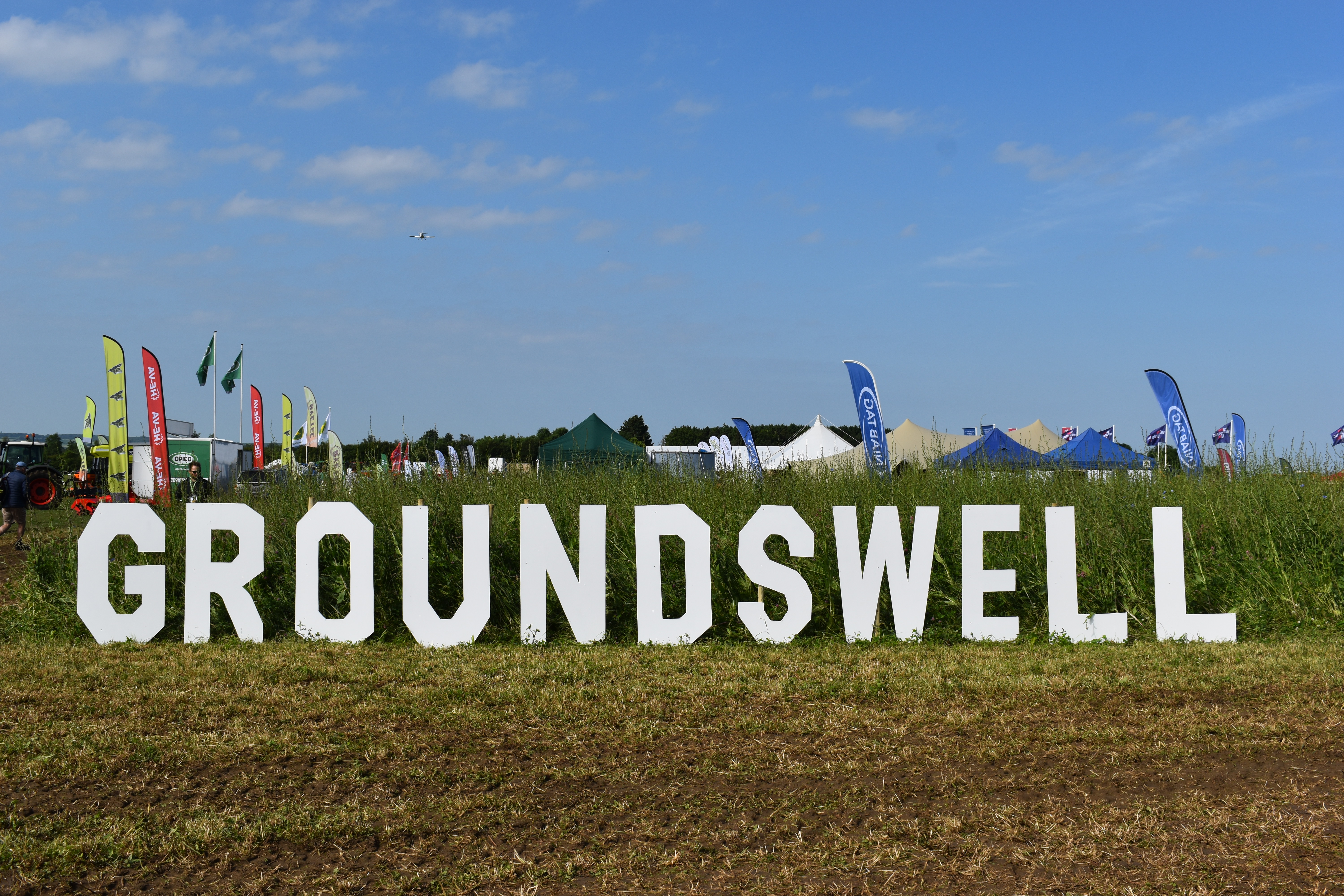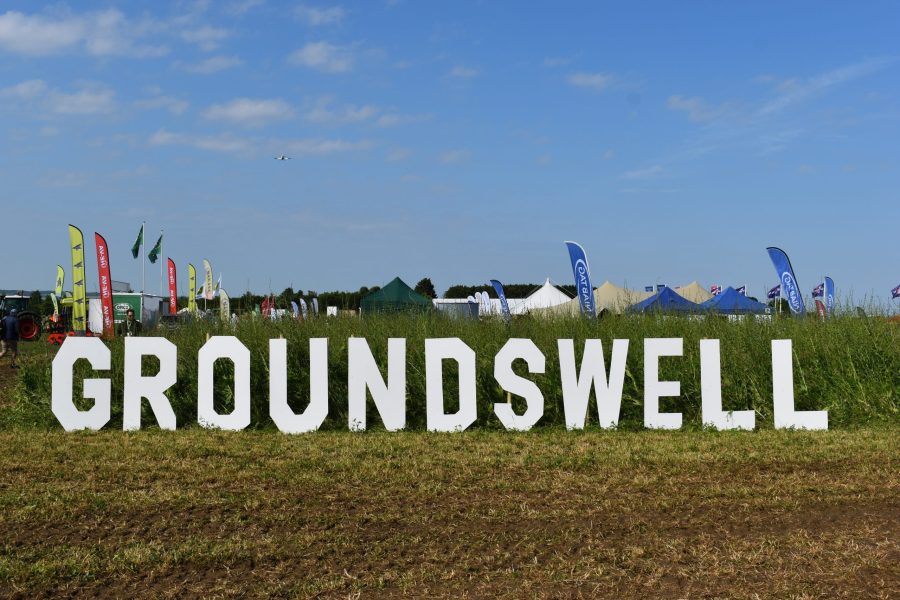
Regenerative agriculture is a direction of travel – not an absolute.
By Charlotte Cunningham
“How many farmers does it take to change a lightbulb? Change, what’s that?” an opening quip that drew laughs from the audience at this year’s Groundswell event – and wow, what a treat the sound of ‘real-life’ laughter was after a difficult 18 months.
Now in its fifth year, Groundswell has become colloquially known as the Glastonbury of the ag show world. However, in the absence of miles of quagmire, and with notably better toilet facilities, the only real comparisons that could be drawn between the two was the bucket-loads of new talent on display.
And change isn’t something that visitors to this event resent, nor fear, with the seminar tents a hub for knowledge exchange and idea sharing with regards to how the five key principles of regenerative agriculture can be adopted on a wider scale – the overriding theme of the event.
“Regen ag is quite simple – it’s a form of farming which at the same time improves the environment,” said Alex Cherry, event director.
“This primarily means regenerating the soil, but it’s a direction of travel – not an absolute.”
The 5 Principles of Regen Ag include:
- Don’t disturb the soil
- Keep the soil surface covered
- Keep living roots in the sun
- Grow a diverse range of crops
- Bring grazing animals back to the land
And while satisfying all of those principles may seem like a tall order, it can really stack up financially, as well as environmentally, explained Gary Markham, Land Family Business, speaking at a seminar on the future of agronomy.
“Farming is embarking on a period of change that most of the current generation of farmers have not experienced. Moving from the comfort of area payments – which on average make up around 84% of income on arable farms included in the Land Family Business (LFB) annual benchmark – to having to apply for specific funding for providing natural capital.
Gary believes that this will put a financial strain on many businesses. “While many farmers have correctly attempted to expand to deal with pressures, expansion has meant tendering for contract farming agreements but on average, a loss of £40-£60/ac (£98.80-£148.20/ha) is made on contracted land.
“But there is another way…”
LFB has been benchmarking a group of regenerative agriculture farming businesses for the 2017-20 harvests – known as the Groundswell Benchmarking Group – to identify if regenerative agriculture production systems can be financially viable.
“Some of the key findings are that in regenerative systems, the average output per unit area is 25% lower, variable costs are 24% lower, gross margins are 28% lower and labour and machinery costs are 30% lower.
“This results in an average margin very similar for both systems of production. However, the range of results within the group is wide – with the top performers achieving results well above the conventional top 25% group.”
In addition to margins, Gary said there are savings in working capital of around £365/ha, which can have a huge impact on farming businesses.
“The main driver of lack of profitability in arable farms are the machinery costs and in particular the depreciation which represents the capital.
“We therefore have developed a key indicator of machinery capital per tonne. The Groundswell group average is £74/t, while the LFB conventional system is £91/t – with the difference between the two coming in at anywhere between £20 and £30/t over the past four harvests.”
But what does this all mean in practice?
“Firstly, the current traditional ‘yield is king’ philosophy doesn’t work,” said Gary. “Secondly, expanding area is not feasible by using traditional contract farming structures. And thirdly, benchmarking data from four harvests proves that there is an alternative approach for growers that is still economically viable.”
And if you’re looking for support to get started, the FABulous Farmers project could be worth looking in to.
The European project is supported by the European Regional Development Fund and the Soil Association for delivering activity in three UK pilot regions – South West, West Midlands and Wales – with the National Trust heading up activity in the East.
The ‘FAB’ in FABulous stands for Functional AgroBiodiversity – targeted measures of biodiversity in and around fields to boost pollination and pest management as well as soil and water quality – and the programme is designed to help farmers identify and adopt the relevant FAB-methods specific to their farm.
Examples of FAB practices include:
- Reduced tillage techniques
- Mixed crops/crop rotations
- Cover/catch crops
- Organic matter input such as plant residuals, wood chips and biochar.
- Modified manure quality and diversity
- Hedgerow management
- Field margin management
- Reduction in the use of plant protection products
- Semi-natural landscape elements to provide habitats.
The Soil Association is currently setting up learning networks which are open to all located within the pilot regions.
And it wasn’t just all about seminars – there was plenty of kit both on stand and working in the demo zones.
Among them was the debut of the izona iPass – a new direct seed drill from British manufacturer izona.
The izona iPass is the brainchild of farmer and engineer, Martin Lole, and has been designed to offer flexible, high output seeding across a range of establishment systems.
Boasting a large 7000 litre split tank the iPass can comfortably accommodate four bags of fertiliser and six bags of seed to allow an output of up to 16ha/tank fill when based on a 180kg/ha seed rate.
Supporting the high-capacity tank, the monocoque chassis features a commercial axle fitted with hydraulic brakes as standard, as well as flotation tyres to minimise compaction and impact.
Interchangeable front points and coulters allow the iPass to be converted from a no-till drill to a strip till or conventional drill at the push of a roll pin.
Operators can choose 5cm single shoot and 7.6cm and 12.7cm double shoot coulters to achieve different row spacings to suit different seeding techniques. 250mm row spaced models, such as the 6m iPass 624 and the 8m iPass 832 can achieve a conventional seed row finish using the 12.7cm coulter which drills individual rows evenly spaced apart across the width of the drill. The iPass can also be available in 333mm row spacings with models including the 618 and the 824.
Summing up the event, hosting farming, Paul Cherry said: “Back in 2016 when we started Groundswell, regenerative agriculture as a name was on the fringe – now, it’s on everyone’s lips. I see it as a chance to really take the lead on showing the best of farming to an increasingly demanding and aware public. We can build natural fertility, we can store carbon, we can improve drinking water and by the way make our own businesses more resilient. I’m more excited by what I’m seeing in agriculture than I have been in the past 35 years.”
Are livestock the future for arable farming?

Sheep grazing Cauliflower’s in the Lincolnshire Fens
The fifth principle of regen ag is ‘bring grazing animals back to the land’ – something that mixed farmers have been doing for some time, but large-scale arable farms are just starting to edge towards.
And while the environmental benefits are clear, can it work on a commercial basis?
Groundswell facilitated a debate with farmers David Miller, George Hosier and Jo Franklin, as well as beef and sheep consultant Liz Genever to discuss the pros and cons of integrating livestock into an arable system.
First up was farm manager, David Miller, who said that after experimenting with sheep in the rotation, it wasn’t a viable option for the Wheatsheaf Farming Company. “We’re an all-arable farm, all combinable crops – farming about 700ha – and made the change to optimising regenerative agriculture principles in 2010 and today, we’re satisfying four of them.
“However, livestock doesn’t work for us.
“In 2014, we had sheep on the farm. We grew some really thick cover crops and at the time didn’t have a disc/no-till drill, so we needed something to remove the green matter.
“We had no idea whether what we had in the mix was good for sheep, but we ended up with 2500 sheep which took everything right down.
“The issue for us is that we run an incredibly simple, low input system and adding livestock to that might complicate or compromise. While things like flying flocks are a great idea, having a shepherd who understands that you don’t want your cover crop grazed completely to the ground is a challenge.
“The other thing that concerned me was that when we first started getting our soils moving in the right direction with no-till, the last thing we wanted was a wet winter and being committed to having someone’s sheep going across the cover crops.
“Now the soil has moved on and improved, maybe we could facilitate it, but for us, it’s not yet an option.”
On the other side of the debate was Jo Franklin who is an advocate of the benefits sheep can bring to the arable rotation.
Herts farmers, Jo and husband, Rob set up their business ‘Kaiapoi’ in 2013 with 200 ewes. Today, they run 2250 ewes across 405ha of semi-improved grassland, alongside 648ha of arable crops.
Jo believes that integrating livestock and arable systems bring huge advantages and cost savings to both enterprises and creates one big profitable, holistic machine. “Working with nature rather than fighting it to benefit sheep, crops, wildlife, landowners, staff, farmers and the environment.
“Recent events within British agriculture have seen unprecedented change – the ending of BPS payments, switch to ELMs and the “public money for public goods” mantra have all combined to create a “perfect storm”.
“Add into the mix the emergence of regenerative agriculture and it is clear farming in even five years will be very different from today.
“Our farming approach positions us somewhat uniquely to take best advantage of Hertfordshire’s mixed soil types. We take out all of the uneconomic arable fields and put them into a mid-tier scheme as arable reversion – which can be returned to arable production at the end of the five-year term if it is profitable to do so.
“In the meantime, the scheme grants capital to cover fencing and running water to these fields which we seed with a legume-rich multi-species grass and herbal ley. We spot spray these leys for thistles, otherwise they receive no inputs – a great opportunity to let nature repair the soil.”
Though Jo is having huge success with her flock, it’s not feasible for every grower who wants to incorporate livestock into the system to go out and buy a flock of sheep. And in all honesty, many specialist arable growers would probably agree that they don’t have the skills necessary to manage livestock.
Which is why consultant, Liz Genever, has set up “carbon dating” – a new hook-up service for livestock farmers who want land and arable farmers who want stock. (Think Tinder, but for sheep). “The overall aim is to help build carbon levels in arable soils.”




